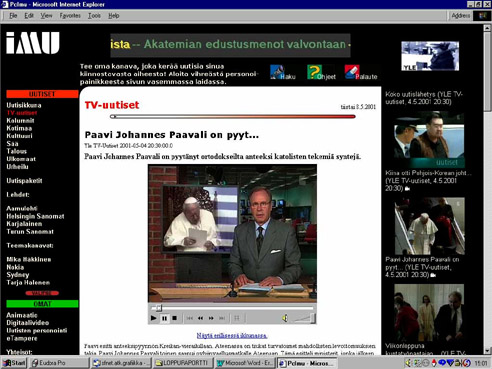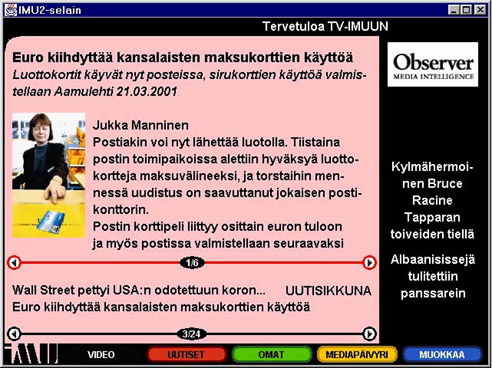
|
|
ERCIM News No.46, July 2001 [contents]
|
by Antti Tammela, Sari Lehtola and Katja Rentto
Complex, multiple service portals are very popular entry points into the internet. To attain more and more users new features have been included to the portals. They combine both audio and video material into the news, chat, community, etc. The IMU system developed at VTT integrates related articles, video clips and media events. Video articles, mostly TV news, and text-based articles are treated and presented in a similar way.
The goal is to integrate content for a multiplicity of distribution channels and receiving terminals. Through PC, TV, WAP and MP3 terminals, the trial users could access the same news content at work, at home in the living room and on the move. One purpose of our research was to examine how the features and functions on PC service works on TV service. A TV Set Top Box was built from a computer to study how these media portal services could be used in a living room with a tv remote control.
Personalisation of News, and Event and Media Calendar
IMU user interface offers a set of channels (Figure 1). One channel type are common channels to which the reader can subscribe (Top News, the weather, etc). The coverage of these channels cannot be changed by the user. In addition to these fixed channels, the user can tailor so-called personal channels according to his or her interests. The reader can, for example, make a sports channel by combining the sports sections from one TV station and one newspaper.
 |
| Figure 1: The IMU publication, where the channels (common and personal) are presented on the left. The channel ‘TV-news’ is selected. A News banner with the top headlines is displayed on the right. |
The PC and TV interfaces are very similar (Figure 2). The same information can be retrieved via the TV and the PC. Of course, the smaller resolution of the television screen, affects the way in which the elements are shown. For example, the news stories cannot be scrolled as on the PC, and have therefore to be paginated. The remote control device has to be taken into account, when designing the TV interface. Most of the commands should be given with the buttons on the remote control.
 |
| Figure 2: TV-IMU is used with a TV remote control. The menu ‘Common channels’ is selected with the remote control red button. The channel ‘Kotimaa’ is selected with the arrow keys. |
Description of Users and the Usability Evaluation
Ten different user groups tried IMU. Out of these 410 potential users, 325 actually used the system. There were also users who tried more than one terminal. Most of the users were males. There were only 50 females who enrolled on trial. Potential users were mostly quite young. 324 of all were under 35 years old. There were also quite many students (160). Most of the potential users were also very experienced computer users. 217 used Internet more than 10 hours per week.
Easiness of Use
PC and WAP systems were considered to be easy to use, TV navigation on the other hand was considered to be difficult to use. The problem on TV was mainly navigating and commanding with remote control that was felt to be difficult and unfamiliar.
Based on the test results, the TV service as such was too difficult for novice users. The features must be cut down, or alternatively the service must be structured to a different user levels like level for novice users and level for expert users. But then again, such a result was to be expected—one meaning of the research was to find out how the same functionality works in TV and in PC.
User Acceptance
PC-IMU service was considered to be reliable and fast. Some users thought that TV-news didn’t appear fast enough. The delay between the actual TV broadcast and the time at which the program was available in IMU service was considered to be too long. Overall test users evaluated IMU to be a relatively useful system. Test users were interested in using IMU if such a system exists. As a competitors to IMU, users mentioned newspapers and other Internet based services. This could partly explain the fact that test users were not very willing to pay for such a service. Test users also hoped that IMU would be updated faster and there were other kinds of content, for example foreign sources.
Link:
IMU: http://www.vtt.fi/imu2/tutustu.html
Please contact:
Antti Tammela — VTT Information Technology
Tel: +358 3 3163 349
E-mail: antti.tammela@vtt.fi